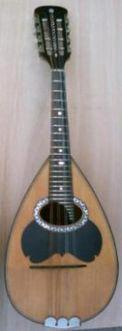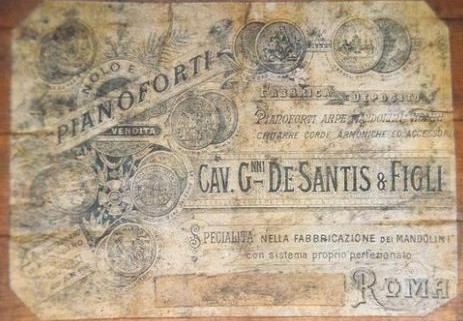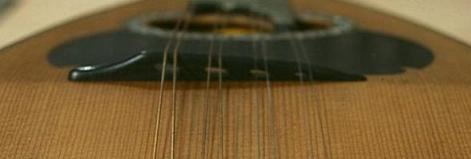Not much is known about Giovanni De Santis, except for that he learned the musical instrument making craft in the ateliers of Paulo Alessandroni and that he was sent abroad to complete a traineeship at the famous Erard pianoforte atelier in Paris. Before making mandolins, mandolas, mandolones, lutes and guitars De Santis made and restored pianofortos, harps and violins. Two Roman workshop locations are known; one at the 'Via del Quiriale 52' and a second one, as found in a mandolin made in 1894 , at the 'Via della Cordonata 28A presso il Quirinale'.
De Santis trained and was succeeded by his son Alberto (b. 1876) who, together with his nephew Auguste, operated under the name 'Figli De Santis'. They were later joined by Alberto's son Renato (b. 1901).
Besides being a well-known Roman mandolinist Giovanni Battista Maldura was a mandolin- and guitar maker who worked in close collaboration with Giovanni De Santis. Their improvements include the Roman headstock with metal tuning devices placed at the side of the head, the reinforcement of the ribs of the sound box with a thin layer of wooden strips; the 'V' shape of the neck, the introducing of a curved bridge and the adoption of a raised, curved and extended ebony fingerboard with 25- up to 29 frets. The curved shape is not the only novelty that can be seen in the fingerboard design. While fret placement on all observed De Santis mandolins is consistent, it is different from fingerboards applied by most other contemporary makers. These differences are especially notable from the 10th through 25th (or 29th ) frets. Interestingly, fret placement on the fingerboards of Embergher mandolins is identical to those that I know by Giovanni De Santis. Also of importance is that Embergher, the Cerrones and Pecoraro, as is proved by their mandolins, never changed this particular characteristic of the Roman mandolin. It is believed that De Santis, as a trained violin maker, applied this different fret placing to intonate the notes in the highest positions in a more accurate and practical way. It is a departure from the rule in the plucked instrument making field, but in fact very similar to what violinsts do when playing in the highest register of their instrument; they intonate slightly sharp, to retrieve a better, more brilliant sound.
A label found in a 1894 De Santis mandolin, also gives more insight in the time when the improvements had first been recognized as important, since it mentions that the first specimen of the 'Mandolino Romana' had been awarded with a gold medal: 'PREMIATA CON MEDAGLIA D'ORO ALLA 1A MOSTRA DI ROMA'. The label also reveals that De Santis was honoured with a silver medal at the 1885 Paris exhibition, while in 1884 he had already been awarded with the silver and bronze medals of the 'Esposizione Generale Italiana' in Turin. Research has produced evidence that in fact the patent 'BREVETTATO DI TASTIERA E PONTICELLO' was owned by Giovanni Battista Maldura and that he inspired Giovanni De Santis to build mandolins to his specifications. Another mandolin prize winner at the 1884 exhibition was the musical instrument maker Enrico Tacconi. Besides a handfull mandolins and a mandola nothing is known about this Roman luthier. Another Giovanni De Santis mandolin made in 1904 bears a new printed label that shows, next to the previous mentioned medals of Paris and Turin, new gold medals won in Rome (1890), Palermo (1891) and Milano (1894) the medal insignia of the knighthood of the Order of the Italian Crown. All these honourable distinctions point out the importance of Cav. De Santis and that the modernising of the mandolin took place in Rome during the early 80-ties of the 19th century.
Information courtesy of the Embergher Website, see links.


